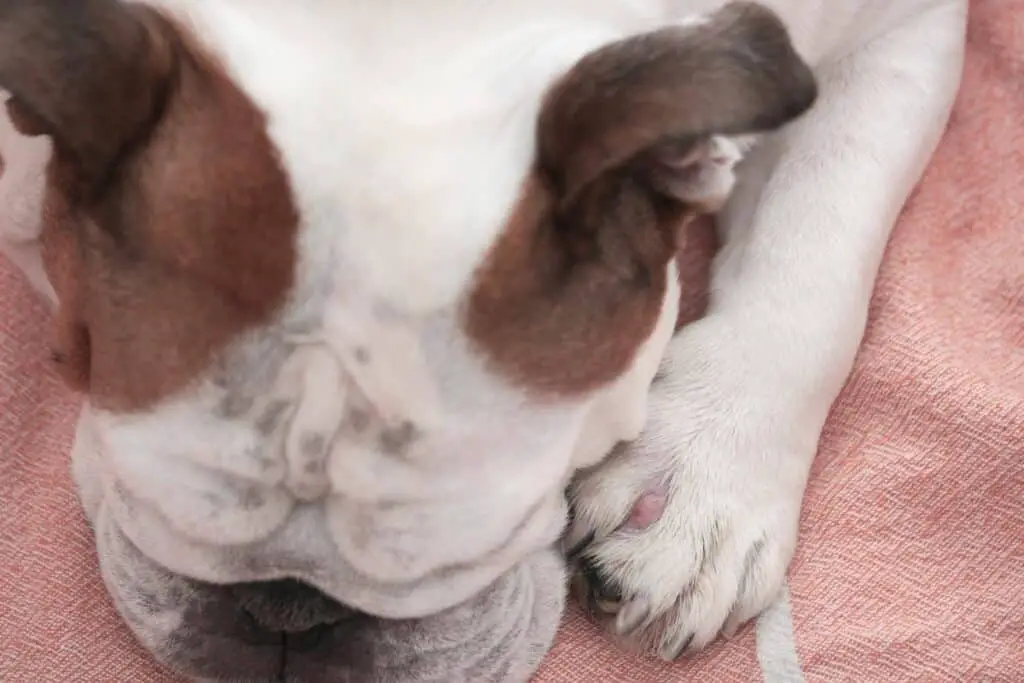Learn more about what happens when your dog has interdigital cysts, including how to treat them and when they should be removed.
What is an Interdigital Cyst?

An interdigital cyst is a fluid-filled sac that forms between the pads of your dog’s feet. They are sometimes called “paw cysts” because they usually form on the bottom or sides of the paws, but can also occur in other areas of the foot such as between the toes and the pad.
Interdigital cysts can be painful for your dog and should be treated by a veterinarian. If you suspect that your dog has an interdigital cyst, you will need to see your vet so he/she can examine your pet and determine if this is what it is.
Interdigital cysts happen when there is an accumulation of fluid under the skin. This fluid can form small bubbles which then grow into larger ones. These large bubbles may eventually burst leaving behind a hole in the paw or other area where the cyst was located.
The good news is that most dogs do not have any long-term effects from having one of these cysts. However, some dogs with very large or multiple cysts may develop chronic pain or infection which can cause lameness.
In those cases, treatment might include draining the cyst, cutting away any inflamed tissue around the cyst, and treating the underlying problem that caused the cyst to form.
Now that we know a bit about interdigital cysts we need to look further into what could cause this kind of affliction in your dog.
What is the Cause of Interdigital Cysts?
There are many reasons your dog might have developed interdigital cysts. Most of the reasons for your dog developing this type of ailment are to do with your dog, how their skin reacts to certain things, and the environment in which they live.
With that in mind, let’s take a look at some of the most common causes of interdigital cysts in dogs below:
- If your dog is Overweight it could cause interdigital cysts.
- The Shape of your Dog’s Paw could be the reason interdigital cysts are developing.
- If your dog has a Short Course Coat that is prone to ingrown hairs.
- Your dog might have a Skin Irritation that causes them to constantly lick their paws.
- The Environment in which your dog walks could be the cause of interdigital cysts.
What are the Symptoms of Interdigital Cysts in Dogs?
Most of the time it is pretty obvious when your dog is suffering from this particular ailment. But if your dog does not have any of these symptoms it might not be an interdigital cyst. At this point, you should take your canine companion to the vet so that they can be properly diagnosed.
Below are several of the most common symptoms of interdigital cysts in dogs:
- Visible Sore – You might notice that your dog has a sore between their toes this could mean that they are suffering from interdigital cysts.
- Excessive Licking – Your dog might have suddenly started licking their foot much more than they usually do which would be a sign that your dog has an interdigital cyst.
- Bleeding Paw – You might see blood on your canine companions’ paws which could mean that they have an open sore on their feet.
- Limping – Your dog may have suddenly started favoring one of their paws and may move with a limp which could indicate an interdigital cyst.
How Will Your Dog Get Diagnosed?
It stands to reason that you may have taken your dog to the vet if you have noticed any of the above symptoms. But what can you expect when your dog is being diagnosed? Will there be diagnostic tests?
Below you will find a shortlist of what your vet may do or advise when they are examining your pet.
- Allergy – Your dog may have an allergy that is causing them to develop these cysts. So your vet may do some tests to determine whether this is the case with your pet.
- Skin Biopsy – Your veterinarian may decide that doing a skin biopsy will be a good way to determine the cause of the interdigital cyst.
- Dog’s History – A good place for your veterinarian to start is by learning about your dogs’ history. Have they suffered from this affliction before? Is there a condition that they need to be aware of when they are treating your dog? Knowing about your dog, what they are prone to, and what conditions they have had or currently suffer from can be indispensable when they are treating your canine companion for interdigital cysts.
- Blood Test – A blood test might be done in order to see if there are any conditions that might be causing the cyst that is not related to ingrown hair or other external factors. For example, a thyroid disease might be the reason your dog has a cyst on their paw.
- Examination – It stands to reason that your veterinarian will examine your dog’s feet. By studying the injury they can more accurately understand what is happening and maybe even root out the cause for your dog’s injury.
How are Interdigital Cysts Treated?

There are a lot of ways that your dog can be treated for interdigital cysts. Depending on the severity of the case and what caused it your veterinarian may suggest different treatments.
Below you will see some of the treatments that your veterinarian may suggest to you:
- Surgery
- Antibiotics
- Anti-inflammatories
- Topical Therapy
Frequently Asked Questions
Below we have a selection of frequently asked questions that we have answered. So, without further ado, let us dive right in.
Will Interdigital Cysts Go Away?
Interdigital cysts tend to go away without treatment, but they often reappear after several years. Some cases get worse over time while others stay stable. It is possible that your dog could develop another cyst at any point.
This means that you should continue monitoring your dog’s foot as well as keeping an eye out for new ones.
Are Interdigital Cysts Serious?
If left untreated, interdigital cysts can become infected and painful. These cysts also weaken the structure of the toe so that it becomes susceptible to fracture.
If your dog suffers from interdigital cysts, then you want to make sure that you take them to the veterinary dermatologist immediately. The sooner you address your dog’s concern the better off you will be.
How can You Get Rid of a Cyst on a Dog?
The best thing to do in order to avoid getting an infection is to properly clean up your dog’s feet. This includes washing the area thoroughly and applying a topical ointment. It is important to keep the wound dry until it heals completely.
In addition to cleaning the area, you will want to make sure that your dog does not lick it. They should never chew on it either because this can lead to infections.
Is There Any Treatment That Can Prevent Interdigital Cysts From Occurring?
Unfortunately, no. If your dog develops interdigital cysts, there is nothing that you can do to prevent them from occurring again.
However, you should always make sure that you treat your dog’s paws as soon as you notice a problem with them.
What Happens if a Cyst is Left Untreated?
It is very common for dogs to suffer from recurring interdigital cysts. As long as you follow through with proper care and attention, you will be able to maintain the health of your dog’s feet.
What Should You Look Out For?
If your dog develops interdigital cysts a pet owner may need to examine the foot for any follicular cysts, foreign bodies bacterial infection, fungal infection, or even atopic dermatitis.
Don’t be scared, a cyst is rarely complicated and most often a result of poor foot conformation, foreign materials causing the lesion, excess weight, or even some kind of food allergy. So, if your dog develops this condition just make sure to keep an eye on the injury and make sure that there is no infection.
If you are at all worried, take your dog to the vet so that they can take professional care.
Final Thoughts
That is all for this article, we hope that you learned everything you need to know about what happens when your dog develops interdigital cysts.
It is important to maintain a level head, if you notice that your dog has developed a cyst. It is usually not serious but if you have any worries it is recommended that you call your vet or take your dog for an examination.
With that in mind, we wish you and your dog a wonderful day. Goodbye for now.
- What Dog Breeds Have Pink Skin? - March 24, 2023
- What Are the Most Inspiring Dog Breeding Quotes? - March 20, 2023
- Can Pheromone Spray Help Improve Dog Breeding Results? - March 19, 2023








